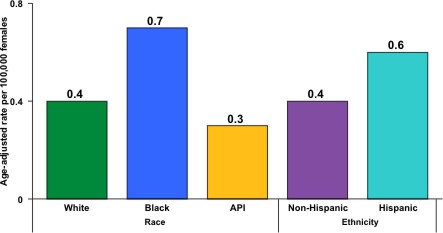|
|
||||||||||||||||
|
|
|
|
|
|||||||||||||
|
|
Control and Prevention Division of Cancer Prevention and Control 4770 Buford Hwy, NE MS K-64 Atlanta, GA 30341-3717 Call: 1 (800) CDC-INFO TTY: 1 (888) 232-6348 FAX: (770) 488-4760 E-mail: cdcinfo@cdc.gov Submit a Question Online |
|
|
|
HPV-Associated Vaginal CancerVaginal cancers are rare. It is estimated that around 600 new cases of HPV-associated vaginal cancer are diagnosed in the United States each year. More black and Hispanic women get vaginal cancer than women of other races and ethnicities, similar to cervical cancer. HPV-associated vaginal cancer rates by race and ethnicity, United States, 1998–2003 
The graph above shows the age-adjusted incidence rates for vaginal cancer in the United States during 1998–2003. The rates shown are the number of women who were diagnosed with vaginal cancer for every 100,000 women. About 0.4 white women, 0.7 black women, and 0.3 Asian/Pacific Islander women were diagnosed with vaginal cancer per 100,000 women. About 0.6 Hispanic women were diagnosed with vaginal cancer per 100,000 women, compared to 0.4 non-Hispanic women. This graph was adapted from Wu X, Matanoski G, Chen VW, Saraiya M, Coughlin SS, King JB, Tao XG. Descriptive epidemiology of vaginal cancer incidence and survival by race, ethnicity, and age in the United States. Cancer 2008;113(S10):2873–2882. These numbers are based on a large study that covered 83% of the U.S. population during 1998–2003, and may under-represent the actual number of cancers diagnosed during this time period. Also, this study used cancer registry data to estimate the amount of potentially HPV-associated cancer in the United States by examining cancer in parts of the body and cancer cell types that are more likely to be caused by HPV. Cancer registries do not collect data on the presence or absence of HPV in cancer tissue at the time of diagnosis. In general, HPV is thought to be responsible for about 40% of vaginal cancers.
Page last reviewed: November 5, 2008
Page last updated: November 5, 2008 Content source: Division of Cancer Prevention and Control, National Center for Chronic Disease Prevention and Health Promotion |
|
||||||||||||
|